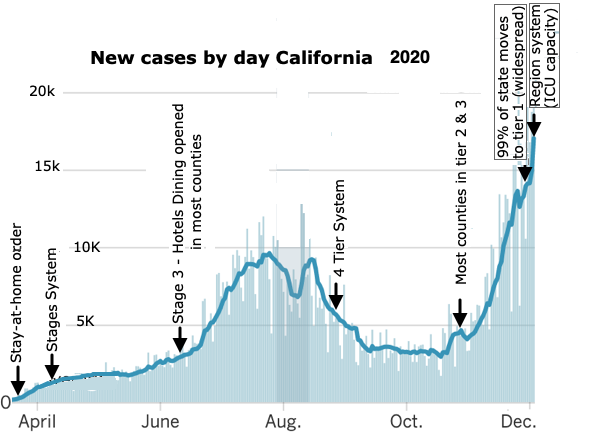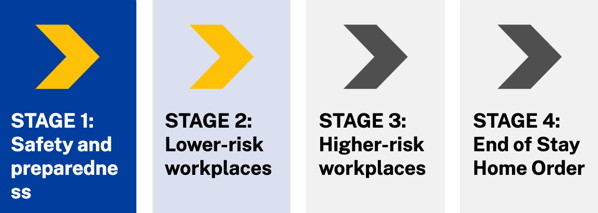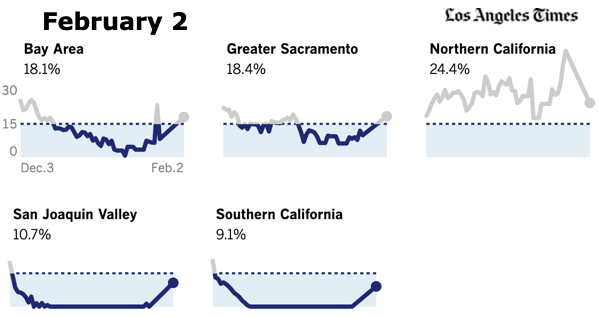 Health | Pandemics
Health | Pandemics
 Corona Virus
Corona Virus
 California
California
 California Timeline
California Timeline
Don's Home
 Health | Pandemics
Health | Pandemics
 Corona Virus
Corona Virus
 California
California
 California Timeline
California Timeline
| Contact |

March 19 - Stay at Home Order
First state to issue a Stay at home order (Shelter in Place).
All individuals living in the State of California are currently ordered to stay home or at their place of residence, except for permitted work, local shopping or other permitted errands.
Essencial Services:

Stage 2: Reopening lower risk workplaces, including: manufacturing, schools, childcare and curbside retail pickup
Stage 3: Reopening higher risk workplaces, which require close proximity to other people, including: hair salons, nail salons, gyms, movie theaters, sports without live audiences, in-person religious services
Stage 4: Ending the stay-at-home order, which would allow for the reopening of: concert venues, convention centers, sports with live audiences
Stage 2:
Who can open in Stage 2:
Limited or Early Stage 2:
WHAT IS OPEN
Curbside retail and dining pickups or deliveries • individual counties may approve in-store shopping • some manufacturing • child care for those outside the essential workforce • office-based business though telework is still encouraged • services like car washes, pet grooming and landscaping • outdoor public spaces like museums and galleries • places of worship with attendance limited to 25% of building capacity up to 100 people, pending approval from individual counties.
WHAT IS OPEN, WITH MODIFICATIONS
Indoor gatherings, including retail and eat-in dining in some counties • personal services such as nail salons, tattoo parlors, gyms and fitness studios • many state parks • schools.
Advanced Stage 2:
WHAT EXTRA IS OPEN, WITH COUNTY-SPECIFIC MODIFICATIONS
Dine-in restaurants and other facilities offering food service with social distancing • barbershops and hair salons with safety measures • schools.
WHAT STILL IS NOT OPEN
Bars, wineries, tasting rooms and gaming areas that do not offer sit-down meals • entertainment venues like movie theaters and arcades • indoor museums, gallery spaces and libraries • zoos • community centers and public pools, playgrounds and picnic areas • limited-capacity indoor ceremonies • nightclubs • concert venues • live sports • festivals • theme parks • gyms and other personal services • hotels for nonessential travel • higher education.
May 8 the stay home order was modified. In addition to essential activity, retail is allowed, along with the infrastructure to support it. California restaurants and shopping malls can soon reopen in counties that meet state standards for testing and success at reducing cases of the coronavirus,
May 26, 2020, Hair salons and barber shops will be allowed to reopen in 47 of the state's counties after being closed because of the coronavirus pandemic.
On June 12 most California Counties were allowed to move to Stage 3 with some indoor dining with table spacing, hotels, short-term rentals, outdoor recreation and other facilities allowed to open.
Most Bay Area counties were still restricted.
Seven of the nine Bay Area counties have reported recent, significant upticks in cases, and the Bay Area as a whole recorded a nearly 40% jump in new cases
On July 1 Governor Newsom announced 19 counties must close indoor restaurants, wineries, tasting rooms, movie theaters, family entertainment centers, zoos, museums and cardrooms for at least three weeks. If possible, those businesses can operate outdoors. Bars and breweries, indoors and outdoors, have been ordered to close..
Contra Costa, Fresno, Glenn, Imperial, Kern, Kings, L.A., Merced, Orange, Riverside, Sacramento, San Bernardino, San Joaquin, Santa Barbara, Santa Clara, Solano, Stanislaus, Tulare., and Ventura.
July 8
The state is monitoring data for elevated disease transmission (case rates and positive test results), increased hospitalizations and limited hospital capacity (availability of ICU beds and ventilators). Any county not meeting threshold criteria in at least one category goes on the watch list.
Marin was on the list and decided to halt indoor dining for at least three weeks in response. Santa Clara was no longer on the list but the previous restrictions remain based on having been on the list for three or more consecutive days.
July 13 Bars, indoor restaurants, movie theaters and many other recently reopened businesses across California are ordered to close.
29 counties on the state watch list must now close gyms, houses of worship, hair and nail salons, offices for noncritical work sectors, shopping malls and barbershops.
In the Bay Area, the more restrictive orders take effect in Contra Costa, Marin, Napa, Solano,Santa Clara and Sonoma counties.
July 17
Newsom releases requirements for schools to physically reopen for the new school year. Under the requirements, 90% of California’s K-12 aged children will begin the next school year doing distance learning.
| County risk Level | New Cases/ 100K | Positivity rate | Activities |
|---|---|---|---|
| Widespread | >7 | > 8% | Many non-essential indoor business operations are closed |
| Substantial | 4-7 | 5-8% | Some non-essential indoor business operations are closed |
| Moderate | 1-3.9 | 2-4.9% | Some indoor business operations are open with modifications |
| Minimal | < 1 | <2% | Most indoor business operations are open with modifications |
All individuals living in the State of California are currently ordered to stay home or at their place of residence, except for permitted work, local shopping or other permitted errands, or as otherwise authorized.
Region Status:

Stay-at-home will go into effect within 24 hours in regions with less than 15% ICU availability.
It will remain in effect for at least 3 weeks. After that period, they will be lifted when a region’s projected ICU capacity meets or exceeds 15%. This will be assessed on a weekly basis after the initial 3 week period.
It allows access to (including travel for) critical services and allows outdoor activities to preserve Californians’ physical and mental health.
What does the Regional Stay at Home Order do? :
In any region that triggers a Regional Stay at Home Order because it drops below 15 percent ICU capacity, all operations in the following sectors must be closed:
Links:
News Releases 2020
About COVID-19 restrictions - Coronavirus COVID-19 Response
Blueprint for a Safer Economy - Coronavirus COVID-19 Response
California Coronavirus COVID-19 Response
COVID-19 | California Department of Public Health
California | The COVID Tracking Project